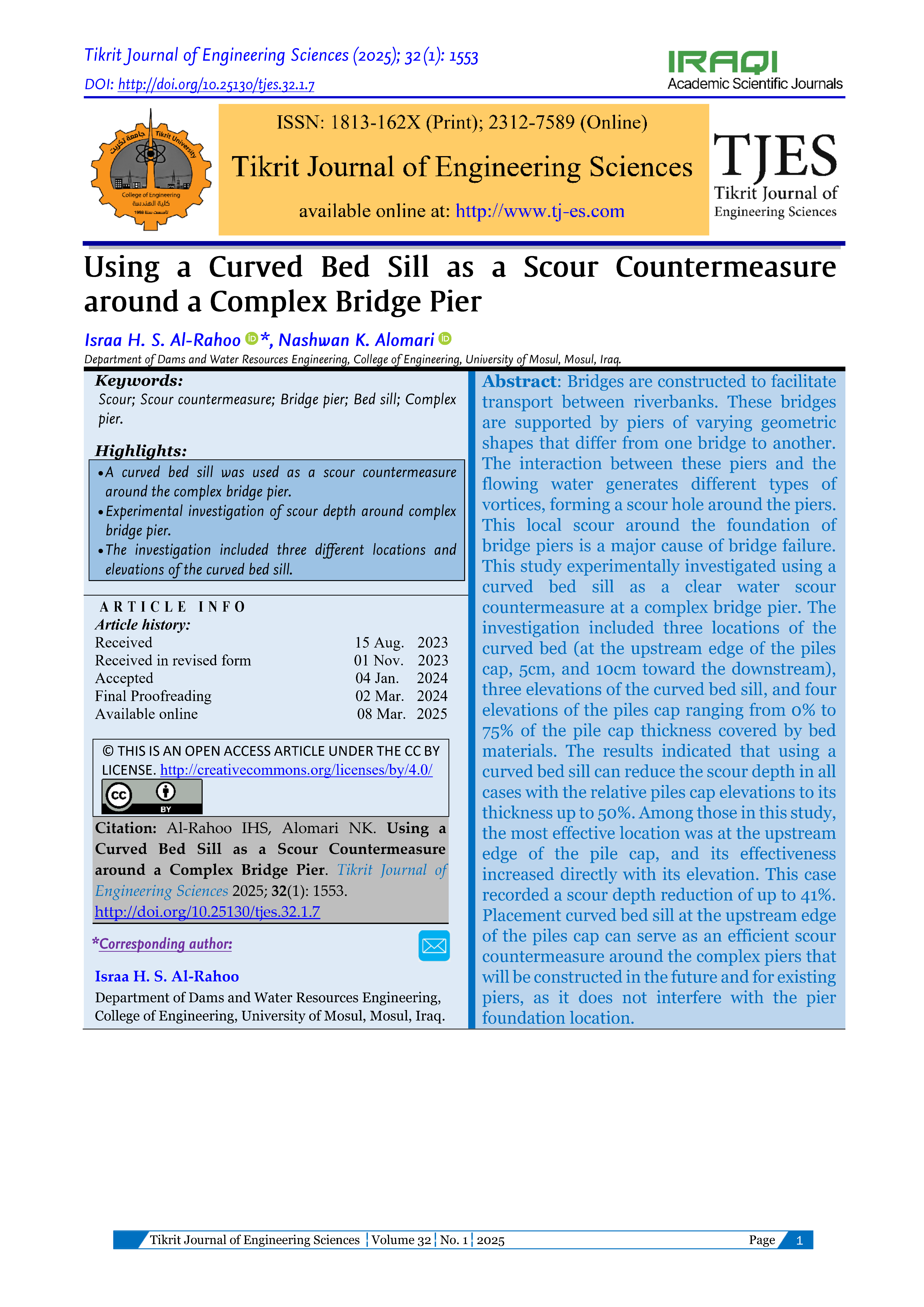Using a Curved Bed Sill as a Scour Countermeasure around a Complex Bridge Pier
Main Article Content
Abstract
Bridges are constructed to facilitate transport between riverbanks. These bridges are supported by piers of varying geometric shapes that differ from one bridge to another. The interaction between these piers and the flowing water generates different types of vortices, forming a scour hole around the piers. This local scour around the foundation of bridge piers is a major cause of bridge failure. This study experimentally investigated using a curved bed sill as a clear water scour countermeasure at a complex bridge pier. The investigation included three locations of the curved bed (at the upstream edge of the piles cap, 5cm, and 10cm toward the downstream), three elevations of the curved bed sill, and four elevations of the piles cap ranging from 0% to 75% of the pile cap thickness covered by bed materials. The results indicated that using a curved bed sill can reduce the scour depth in all cases with the relative piles cap elevations to its thickness up to 50%. Among those in this study, the most effective location was at the upstream edge of the pile cap, and its effectiveness increased directly with its elevation. This case recorded a scour depth reduction of up to 41%. Placement curved bed sill at the upstream edge of the piles cap can serve as an efficient scour countermeasure around the complex piers that will be constructed in the future and for existing piers, as it does not interfere with the pier foundation location.
Metrics
Article Details

This work is licensed under a Creative Commons Attribution 4.0 International License.
THIS IS AN OPEN ACCESS ARTICLE UNDER THE CC BY LICENSE http://creativecommons.org/licenses/by/4.0/
Plaudit
References
Hosseini SA, Osroush M, Kamanbedast AA, Khosrojerrdi A. The Effect of Slot Dimensions and its Vertical and Horizontal Position on the Scour Around Bridge Abutments with Vertical Walls. Sādhanā 2020; 45(1):1–16. DOI: https://doi.org/10.1007/s12046-020-01343-z
Salih IH, Alomari NK. The Effect of the Piles Cap Elevation on Local Scour Around Complex Bridge Piers. Al-Rafidain Engineering Journal 2023; 28(2):199–208. DOI: https://doi.org/10.33899/rengj.2023.139205.1245
Khaleel MS, Juma IA, Hammo NI. Effect of Bridge Piers Inclination and Roughness on Scour Pit Dimensions. Tikrit Journal of Engineering Sciences 2008; 15(1):14–27. DOI: https://doi.org/10.25130/tjes.15.1.07
Sanadgol E, Heidarpour M, Mohammadpour R. Reduction of Local Scouring at Round-Nosed Rectangular Piers Using a Downstream Bed Sill. Journal of the South African Institution of Civil Engineering 2021; 63(3):62–70. DOI: https://doi.org/10.17159/2309-8775/2021/v63n3a6
Abdulhafedh AY, Alomari NK, Al-Janabi AMS. Scour Hole Reduction at a Diversion Channel Junction Using Different Entrance Edge Shapes. International Journal of Sediment Research 2023; 38(6):811-820. DOI: https://doi.org/10.1016/j.ijsrc.2023.07.001
Alomari NK, Sihag P, Sami Al-Janabi AM, Yusuf B. Modeling of Scour Depth and Length of Diversion Channel Flow System with Soft Computing Techniques. Water Supply 2023; 23(3):1267-1283. DOI: https://doi.org/10.2166/ws.2023.026
Varaki ME, Tavazo N, Radice A. Using a Bed Sill as a Countermeasure for Clear-Water Scour at a Complex Pier with Inclined Columns Footed on Capped Piles. Hydrology 2022; 9(4):65. DOI: https://doi.org/10.3390/hydrology9040065
Moreno M, Muralha A, Couto L, Maia R, Cardoso AH. Influence of Column Width on the Equilibrium Scour Depth at a Complex Pier. In: Proceedings of 36th IAHR World Congress; The Hague, The Netherlands: 2015.
Yang Y, Melville BW, Sheppard DM, Shamseldin AY. Clear-Water Local Scour at Skewed Complex Bridge Piers. Journal of Hydraulic Engineering 2018; 144(6):4018019. DOI: https://doi.org/10.1061/(ASCE)HY.1943-7900.0001458
Martinez F, Winckler P, Zamorano L, Landeta F. Bridge Pier Scour in Complex Environments: The Case of Chacao Channel in Chile. Water 2023; 15(2):296. DOI: https://doi.org/10.3390/w15020296
Tafarojnoruz A, Gaudio R, Calomino F. Evaluation of Flow-Altering Countermeasures Against Bridge Pier Scour. Journal of hydraulic Engineering 2012; 138(3):297–305. DOI: https://doi.org/10.1061/(ASCE)HY.1943-7900.0000512
Pande, Y M, Pu JH, Pourshahbaz H, Khan MA. Reduction of Scour Around Circular Piers Using Collars. Journal of Flood Risk Management 2022; 15(3):e12812. DOI: https://doi.org/10.1111/jfr3.12812
Keshavarzi A, Gazni R, Homayoon SR. Prediction of Scouring Around an Arch-Shaped Bed Sill Using Neuro-Fuzzy Model. Applied Soft Computing 2012; 12(1):486–493. DOI: https://doi.org/10.1016/j.asoc.2011.08.019
Alsaidi MI, Hayawi GAA-M, Alsawaf MA. Study of Scour Around Cylindrical Bridge Piers with Circular Openings. Al-Rafidain Engineering Journal (AREJ) 2020;25(2):66–74. DOI: https://doi.org/10.33899/rengj.2020.126863.1029
Wang L, Melville BW, Whittaker CN, Guan D. Effects of a Downstream Submerged Weir On Local Scour at Bridge Piers. Journal of Hydro-Environment Research 2018; 20:101–109. DOI: https://doi.org/10.1016/j.jher.2018.06.001
Ali KYT, Noori BMA. Protection of Open Channels Using Gabions. Al-Rafidain Engineering Journal 2010; 18(2):36–48. DOI: https://doi.org/10.33899/rengj.2010.28176
Melville BW, Sutherland AJ. Design Method for Local Scour at Bridge Piers. Journal of Hydraulic Engineering 1988;114(10):1210–1226. DOI: https://doi.org/10.1061/(ASCE)0733-9429(1988)114:10(1210)
Ferraro D, Tafarojnoruz A, Gaudio R, Cardoso AH. Effects of Pile Cap Thickness on the Maximum Scour Depth at a Complex Pier. Journal of Hydraulic Engineering 2013; 139(5): 482–491. DOI: https://doi.org/10.1061/(ASCE)HY.1943-7900.0000704





